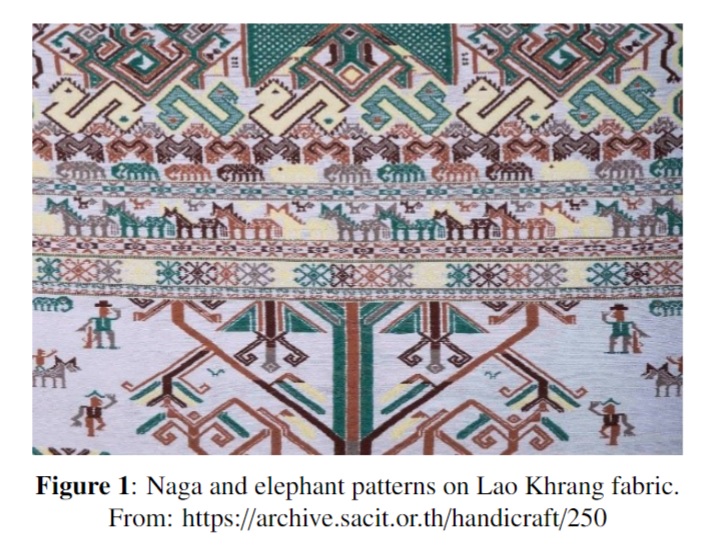Silk threads, auspicious symbols on woven cloth of Lao Khrang people, Nakhon Pathom
Main Article Content
Abstract
The purposes of this research were to study 1) the wisdom of the Lao Khrang ethnic group in Nakhon Pathom, 2) the patterns on woven cloth of Lao Khrang in Nakhon Pathom, and 3) the auspicious symbols on the woven cloth of Lao Khrang people in Nakhon Pathom. Qualitative research is used in this study. The sample was selected using a specific method, i.e., the study of auspicious symbols on the ancient traditional woven cloth in Nakhon Pathom province, such as the woven fabric of the Phrong Maduea Subdistrict Municipality. The results of the study were as follows: 1) the wisdom of Lao Khrang Ethnic Group in weaving has been inherited since the immigrants from Laos to Nakhon Pathom. There is a community of Lao Khrang ethnic group that still maintains the art of weaving in ancient ways, preserving ancient fabric textiles, i.e., Ban Phrong Maduea community. They have woven silk and cotton into fabrics with discontinuous supplementary weft techniques. The woven cloth is used for two purposes: daily life, and Buddhist ceremony and tradition. Therefore, woven fabrics are not only beautiful with patterns and colors but there is also a characteristic identity showing the way of life, faith, belief, and traditions of the community. 2) The woven pattern imitates natural and geometric patterns. The technique of discontinuous supplementary weft is used to create various textiles by adding special weft threads for inserting up and down. There is a textile of weft lines with patterns of periodic textiles and it came in different patterns and colors. 3) The auspicious symbols of Lao Khrang people are the pattern woven into the fabric. The silk threads are woven in accordance with beliefs in Buddhist and agricultural society. The symbols represent auspiciousness and good luck, including patterns that indicate fertility and auspicious animals in Buddhajataka and legends, such as Naga, elephant, swan, and lion.
Article Details

This work is licensed under a Creative Commons Attribution-NonCommercial-NoDerivatives 4.0 International License.
References
N. Rasmiphaiboon, Project for the development of quality standards for fabric products from Lao Krang, Village No. 4, Ban Thung, Huai Khamin Subdistrict Dan Chang District Suphanburi Province. Bangkok: Research Report, Suan Dusit Rajabhat University, 2006
B. Pasankul,Former director of Wat Konglad School, Interview, 2020.
R. Suksaengsuwan, Tai Khang, Thai Wiang. Bangkok: Wisdom, 2004.
W. Wuttakul, Y. Phanyura, Woven fabrics and Thai way of life, Bangkok: Department of Cultural Promotion, 1993.
S. P. Noi, Himmapan animals, Bangkok: Reed Tree, 1999.
S. Samanchat, Woven fabrics of the Thai-Krang group. Identification, patterns and colors. Bangkok: Department of Cultural Promotion, 2019.
S. Weerawong, Translated by Sommai Premjit, Lao history. Bangkok: Matichon, 1997.
S. Chumsai Na Ayudhya, Water, the source of Thai culture. Bangkok: Association of Siamese Architects, 1996.
S. Wankhrue, C. Tangthawornsirikul, Lao cloth: Migration of cloth culture from the Mekong River basin to Chao Phraya River Basin. Bangkok: Department of Cultural Promotion, 1994.
Mae Lat Subdistrict Administrative Organization, Culture, historical development. Identity and wisdom Mae Lat Subdistrict, Khlong Khlung District Kamphaeng Phet Province, Kamphaeng Phet: Mae Lat Subdistrict Administrative Organization Kanchana Chansing, 2015.


